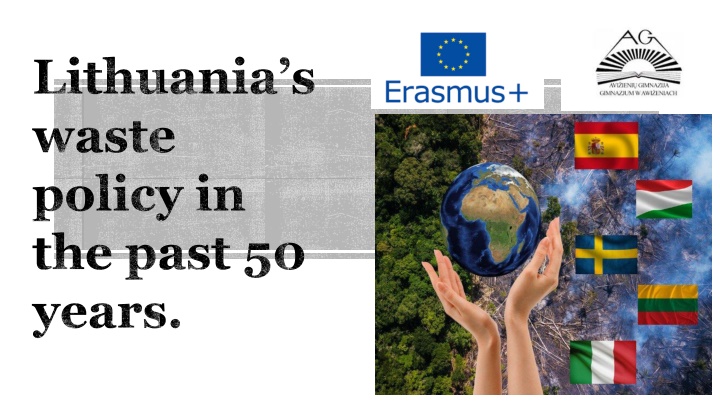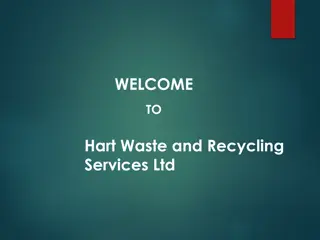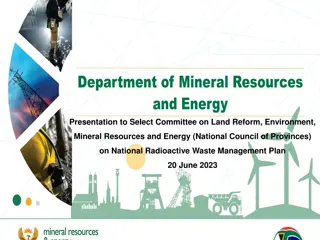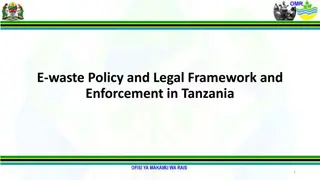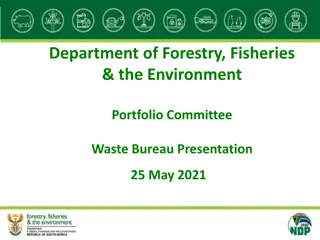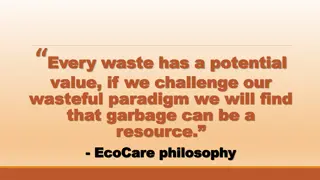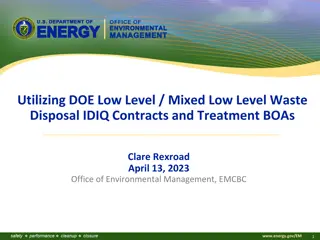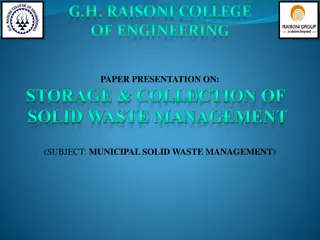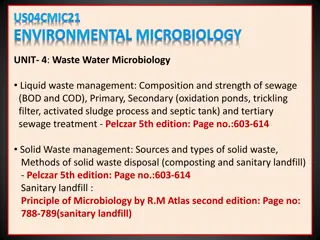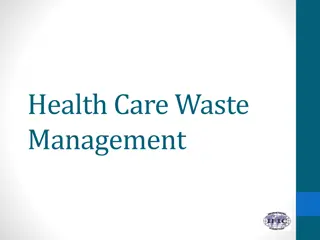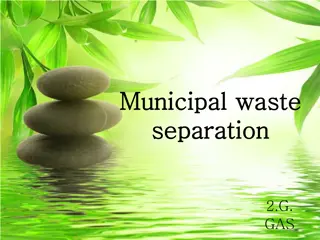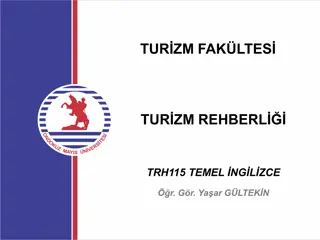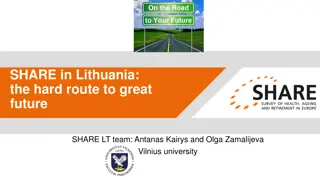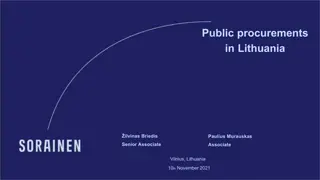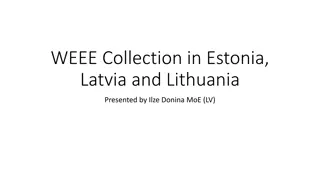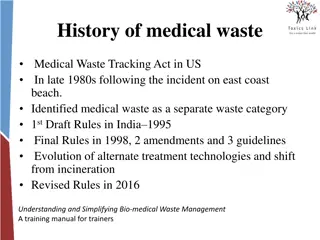Lithuania’s waste policy in the past 50 years
Lithuania's waste policy has undergone significant transformations in the past five decades, reflecting changing priorities and environmental awareness. From rudimentary practices to comprehensive strategies, the country has navigated challenges and adapted to new norms. This evolution sheds light on the intricate relationship between governance, sustainability, and societal values, offering insights for future developments in waste management and environmental protection.
Download Presentation

Please find below an Image/Link to download the presentation.
The content on the website is provided AS IS for your information and personal use only. It may not be sold, licensed, or shared on other websites without obtaining consent from the author.If you encounter any issues during the download, it is possible that the publisher has removed the file from their server.
You are allowed to download the files provided on this website for personal or commercial use, subject to the condition that they are used lawfully. All files are the property of their respective owners.
The content on the website is provided AS IS for your information and personal use only. It may not be sold, licensed, or shared on other websites without obtaining consent from the author.
E N D
Presentation Transcript
Lithuanias waste policy in the past 50 years.
Lithuania's waste policy in the past 50 years. Lithuania - part of Soviet Union also known as Soviet Lithuania, one of the constituent republics of the USSR (1944 1990). Republic of Lithuania- independent country (1991). Lithuania joins European Union (2004). Improving Lithuania s waste policy (2010-2020)
Waste policy in Soviet Union Ecology and clean nature were rarely taken care of in the Soviet Union Lack of plastic, all the packaging was made from paper. Landfills in every collective farm, more than 800 of them. Lots of materials like fabrics, paper and glass were reused Polluted water, ammonia poured into streams. Due to shortages of food, no food waste, or very small amounts. No waste bins provided. Waste collection once a week.
Lithuania - independent country Like other democratic constitutions, Lithuania lays down basic civil rights and obligations, although it does not include a specific right to a healthy environment, it nevertheless obliges citizens to protect the environment The Department of Environmental Protection was created in July 1990 as an independent agency directly subordinated to the Seimas. The Law on Environmental Protection (LEP) of 21January l992 lays down the basic principles of environmental protection. Its main objective is to achieve an ecologically sound and healthy environment on which human activities have littlenegative impact The Law foresees environmental impact assessments (EIA) and prescribes the polluter- pays principle. It also encourages citizens and public organizations to participate in environmental protection. There are many government resolutions, decrees and other regulatory measures aimed at protecting the environment and using natural resources rationally. Since 1991 environmental charges have been imposed on pollution and on the use of resources. The Seimas is currently considering a new draft law on pollution charges. Lithuania is also a party to a number of international environmental conventions and treaties
Selected environmental legislation Laws Law on Environmental Protection (1992) Law on Environmental Impact Assessment (1996) Laws on Land (1994) Land Reform (1991) Laws on the Protection Use of Wildlife (1991) Protected Areas (1993) Law on Forestry (1994) Law on Waste Management (1998) Law on Clean air 1991 Law on Environmental Pollution Charges (1991) Law on Nuclear Energy (1996) Law on Energy (1997) Law on Environmental Monitoring (1997).
The following priorities for environmental policy and management are identified in NEPP (1995) and environmental legislation: Waste-water treatment and reduction of discharges Air pollution reduction Hazardous waste management Domestic and other non-hazardous waste management Protection from physical pollution Optimization of land use and forest structure Prevention of further natural landscape degradation Protection of ecologically sensitive and natural areas Rehabilitation of abandoned quarries Rational use of natural resources
In 1996: Lithuania generated 1 444 000 tonnes of household waste or approximately 384 kg per person. Data on the waste generated by the various industrial activities are difficult to interpret and may be unreliable. Roughly, glass, paper and bone materials are reused. Building material and food wastes have grown drastically in recent years and are not recycled. The food industry is in general a big air and water polluter, and a large solid waste producer. Its pollution is organic, mostly non-toxic, but eutrophying 360 000 t of paper and cardboard waste, 67 000 t of glass and 42 000 t of plastic and metal wastes were disposed of at landfills
In 2000: Waste management policy is based on implementing EU requirements Establishment of 10 Regional Waste Management Systems (11 regional landfills ) Closing of landfills which not comply with environmental requirements Establishment of 10 Regional Waste Management Centres (RWMC) RMWC legal entities, whose main purpose is to implement effectively waste management tasks and to create waste management system
Lithuania part of EU On 1 May 2004, Lithuania became one of the 28 Member States of the European Union. Lithuania embraces different spheres of politics, including waste policy, which states: To reduce the amount of waste generated; To maximise recycling and re-use; To limit incineration to non-recyclable materials; To phase out landfilling to non- recyclable and non-recoverable waste; To ensure full implementation of the waste policy targets in all Member States.
Improved Lithuanias waste policy in the last decade In 2014, Lithuania sent 59 % of its municipal solid waste (MSW), 0.7 million tonnes, to landfill, compared with 92 %, 1.2 million tonnes, in 2004. Since 2004, the recycling, including composting, rate of MSW has increased, reaching 31 % in 2014. The country did not achieve the 2010 diversion target of biodegradable municipal waste (BMW) set in the Landfill Directive Lithuania has a derogation period of four years for the 2006, 2009 and 2016 targets of the EU Landfill Directive. However, considerable progress has been achieved since 2011 and, as a result, Lithuania reached its landfill diversion target for 2013. The new national waste management plan (NWMP) for the period of 2014 2020 was adopted in 2014 and the Waste Prevention Programme for the same period was adopted in 2013. Introduction of a landfill tax in 2016 was an important incentive to divert waste from landfill and enhance recycling. Several new waste treatment and recycling facilities will be established in Lithuania in the near future.
The European Commissions next Circular Economy Action Plan Establish ambitious and binding waste prevention and reuse targets Set mandatory food waste prevention target of 50% by 2030 Define comprehensive circular design requirements for all products Ensure clean, safe and non-toxic material cycles Establish effective economic incentives for resource-saving strategies Prioritise waste prevention within Extended Producer Responsibility (EPR) schemes Stimulate reusable packaging Control & limit global shipment of waste Set the right legal framework for chemical recycling Phase-out of incineration
